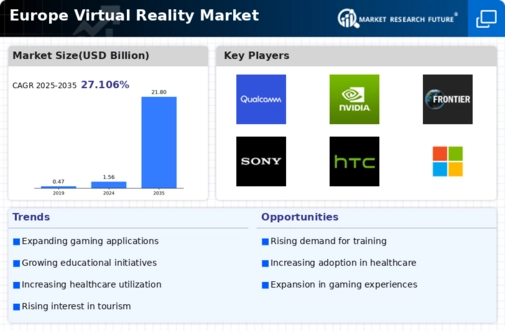Advancements in Hardware Technology
Technological advancements in hardware are significantly influencing the virtual reality market in Europe. The introduction of more powerful and efficient VR headsets, such as those featuring higher resolution displays and improved motion tracking capabilities, is enhancing user experiences. For instance, the latest VR headsets are now equipped with features that reduce motion sickness and increase comfort during prolonged use. This evolution in hardware is expected to contribute to a projected market growth of around 25% by 2028. As manufacturers continue to innovate, the virtual reality market is likely to see a broader adoption of VR technologies across various applications, including training, education, and healthcare, thereby expanding its reach and impact.
Growing Demand for Immersive Experiences
The virtual reality market in Europe is witnessing a notable surge in demand for immersive experiences across various sectors. This trend is particularly evident in the entertainment and gaming industries, where consumers increasingly seek engaging and interactive content. According to recent data, the gaming segment alone is projected to grow at a CAGR of approximately 30% from 2025 to 2030. This growing appetite for immersive experiences is driving companies to invest in advanced VR technologies, thereby enhancing the overall virtual reality market. Furthermore, as consumers become more accustomed to high-quality VR experiences, the expectation for innovation and improved user engagement continues to rise, compelling developers to push the boundaries of what is possible in virtual environments.
Rising Interest from the Healthcare Sector
The healthcare sector's rising interest in virtual reality technologies is emerging as a key driver for the virtual reality market in Europe. Medical professionals are exploring VR for various applications, including pain management, rehabilitation, and surgical training. Studies indicate that VR can reduce patient anxiety and improve outcomes in therapeutic settings. The market for VR in healthcare is projected to grow significantly, with estimates suggesting a CAGR of around 28% through 2030. This growing integration of VR into healthcare practices is likely to enhance the virtual reality market, as more healthcare providers recognize the potential benefits of immersive technologies in improving patient care and training medical personnel.
Increased Adoption in Education and Training
The virtual reality market in Europe is experiencing increased adoption within the education and training sectors. Educational institutions are leveraging VR technologies to create immersive learning environments that enhance student engagement and retention. For example, VR simulations are being utilized in medical training, allowing students to practice procedures in a risk-free setting. This trend is supported by a growing body of evidence suggesting that immersive learning can improve knowledge retention by up to 70%. As educational institutions recognize the benefits of VR, investment in this technology is expected to rise, further propelling the virtual reality market. The potential for VR to transform traditional learning methods is becoming increasingly apparent, leading to a more widespread implementation in curricula.
Supportive Government Initiatives and Funding
Supportive government initiatives and funding are playing a crucial role in the development of the virtual reality market in Europe. Various European governments are actively promoting the adoption of VR technologies through grants, subsidies, and research funding aimed at fostering innovation. For instance, initiatives aimed at enhancing digital skills and promoting technology in education are encouraging the integration of VR into various sectors. This governmental support is expected to stimulate growth in the virtual reality market, as it lowers barriers to entry for startups and established companies alike. As public and private sectors collaborate to advance VR technologies, the overall market landscape is likely to become more dynamic and competitive.




















Leave a Comment